

What are Trailer Sway Bars and are They Necessary?

If you’ve recently purchased a new travel trailer then you more than likely have heard about trailer sway bars and all the benefits they provide.
But what are trailer sway bars and are they even necessary ?
Trailer sway bars are bars that attach to and provide an additional connection point between the tow hitch and the tongue of the trailer that reduces and dampens trailer sway through friction.
There’s a lot more to know about trailer sway bars though than just their basic purpose. So if you’re thinking about purchasing trailer sway bars or want a more in-depth explanation about how they work, keep reading.
In-Depth Explanation on How Trailer Sway Bars Work
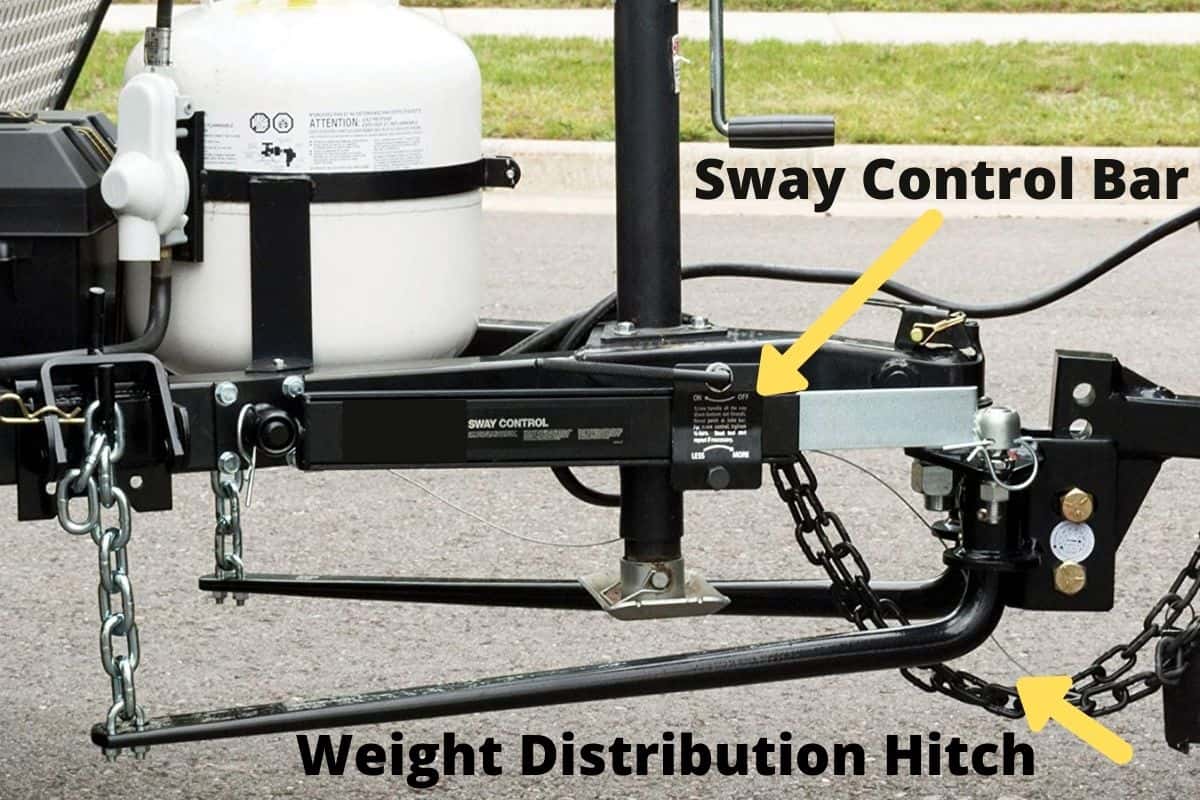
Why Does My Travel Trailer Sway?
The hitch point between the tow vehicle and the travel trailer is essentially one big hinge allowing the truck and trailer to move independently from one another.
This hinge point between the tow vehicle and the travel trailer is important because it allows the rig to turn easier and adjust for elevation differences between the tow vehicle and the trailer on uneven terrain.
However, this hinge point can also cause trailer instability and trailer sway.
Trailer sway is caused when untended outside forces act on the hinge point between the tow vehicle and the trailer, causing the trailer to sway back and forth.
Which can lead to a challenging tow or even an accident if the trailer sway becomes out of control.
The four main outside forces that cause a travel trailer to sway include wind, crosswinds from passing vehicles, improperly aligned tires on the travel trailer, and improper weight distribution between the tow vehicle and the travel trailer.
Why Every Travel Trailer Should Be Equipped with Trailer Sway Bars
While you can technically pull a travel trailer without sway bars, in our opinion you should always have trailer sway bars equipped to help provide the easiest and safest tow possible.
This is because sway bars do a great job of dampening and even eliminating unintended sway in the trailer by creating a more rigid hitch point between the tow vehicle and travel trailer.
Creating a much safer and more manageable towing experience no matter the outside forces you might encounter while towing such as high winds or crosswinds from passing vehicles.
Trailer Sway Bar Installation
While there can be differences in the way you install a sway bar to your trailer depending on the type and brand of the sway bar, this video as well as these step-by-step directions should give you a good general idea of how to install a sway bar to your trailer.
- Mount the sway control ball to the hitch.
- Attach the trailer tongue ball plate using the included bolts by drilling and screwing the plate to the trailer tongue. (Before drilling, make sure there are no electrical or gas lines in your way, and if the tongue ball plate requires any welding make sure a qualified welding professional completes the welds.)
- Apply a small amount of grease to both sway control balls.
- Attach and secure the socket of the sway bar over the sway control ball on the hitch.
- Adjust and attach the body of the sway control arm to the sway control ball on the tongue ball plate.
- Tighten the sway bar control as recommended by the manufacturer.
- Once installed, make sure the trailer sway bar has free range of motion and does not make contact with either the bumper or the trailer frame and ensure it does not become fully compressed by slowly backing the trailer into a jackknife position on either side.
Do You Need One or Two Sway Bars on the Trailer?
For most travel trailers, one sway bar is usually enough as one sway bar is intended for travel trailers that are less than 6,000 pounds and less than 26 feet long.
If however, you have a larger travel trailer that is over 6,000 pounds or longer than 26 feet, you should install a trailer sway bar to both sides of your trailer to prevent unwanted sway on your trailer.
What’s the Difference Between Trailer Sway Bars and a Weight Distribution Hitch?
It’s not uncommon for beginning RVers to be confused about the differences between a trailer sway bar and a weight-distribution hitch and sometimes even think they are the same thing.
But while they can be sold together as a set, a trailer sway bar and a weight-distribution hitch are two separate pieces of equipment that are designed to do very different things.
Trailer Sway Bar

A trailer sway bar such as this popular one on Amazon by Reese is a device that helps to prevent the trailer from swaying back and forth while going down the road by adding an additional connection point or arm between the tow hitch and the trailer tongue, by using friction to make the hinge point between the tow vehicle and the travel trailer stiffer.
While a trailer sway bar can be a part of an overall tow system that might include a sway bar as well as weight-distribution hitch they are also sold separately like the one above.
Weight Distribution Hitch
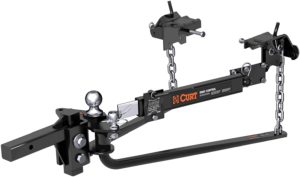
A weight-distribution hitch like this popular one on Amazon by Curt that also has a sway bar built-in, is a device that helps to move some of the tongue weight of the trailer to the front axle of the tow vehicle using downward pressure and leverage.
The reason you would use a weight-distribution hitch to move some of the trailer tongue weight from the hitch point to the tow vehicle’s front axle is to prevent sag at the hitch point between the tow vehicle and the trailer and to help keep the tow vehicle level.
This helps to prevent the front wheels of the tow vehicle from lifting up which can lead to poor steering and stopping power.
Do Fifth Wheels Sway or Need Trailer Sway Bars?
While it’s possible for a fifth to sway during extremely windy conditions, in general, fifth wheels do not sway or need trailer sway bars as other travel trailers do.
This is because the trailer hitch point on a fifth wheel is brought forward over the rear axle of the tow vehicle instead of behind it, allowing the tow vehicle and fifth wheel to act more like a signal vehicle as opposed to separate ones.
Because of this many RVers find fifth wheels more stable and in general easier to tow compared to standard travel trailers once they get used to the fifth wheel’s larger size.
Want to know how the “80 Rule for Towing” influences max towing capacity, if so, check out our article “ How the 80 Rule for Towing Affects Max Tow Capacity “.
Jason is an avid lover of RVs and the RV lifestyle. He is both a writer and editor for RV Owner HQ and has been RVing and camping for over 20 years.
Recent Posts
12 Popular Travel Trailers Under 3000 lbs (Ultra-Lightweight)
Travel trailers come in a variety of sizes and weights, ranging from tiny teardrop campers that are less than 1,000 pounds to full-time luxury campers tipping the scales at almost 10,000...
12 Must-See Small Lightweight Truck Campers with Bathrooms
The world of RVing has evolved, and more people than ever are looking for compact, self-contained campers. Among these, small truck campers with bathrooms have gained significant popularity,...

Home » Guides » How Do Sway Bars Work? (Do You REALLY Need Them?)
How Do Sway Bars Work? (Do You REALLY Need Them?)

- Last Updated: Mar 26, 2024
Are you wondering how sway bars work?
You’re in the right place!
In this LearningRV.com guide, you’ll learn:
- What they are
- How sway bars work
- How to install them
- And much more!

Have you ever experienced the feeling of your travel trailer swinging from side to side behind your vehicle?
It’s a scary experience and for good reason — trailer sway can cause accidents.
This problem can be avoided with the use of sway bars. In this article, we will go over the fundamentals of sway bars for travel trailers.
We will also discuss:
- What causes trailer sway
- How a sway bar for travel trailers work
- A few safety tips when pulling your travel trailer
Jump To A Section
What is a sway bar.
For most vehicles, a sway bar is an addition to the suspension system that reduces the chances of rollover accidents by adding stability and redistributing weight as the vehicle drives.
However, for trailers or campers, a sway bar (or sway controller) is part of a trailer or camper’s hitch setup, not part of the suspension system.
The sway bar is an adjustable bar with a friction plate that attaches to points on the hitch and trailer and works to reduce the trailer’s ability to swing or sway behind your vehicle as you drive.
Many newer style weight distribution systems have built-in sway control.
What Causes Trailer Sway?
Trailer sway is most commonly caused by crosswinds, either naturally occurring or from other vehicles driving past you, or by slowing down your towing vehicle.
These situations cause outside forces to affect your trailer, which does not have the ability to make corrections like you would for your vehicle.
In the case of crosswinds, the trailer is being pushed to one side and it reacts by swaying back and forth.
When your vehicle slows down, the trailer may not slow at the same rate and will end up swaying behind your vehicle as a result.
For safety, you want as little sway as possible as too much sway can result in very serious accidents.
Related >> Leveling a Travel Trailer Properly

How Does a Sway Bar for Travel Trailers Work?
Sway bars limit the degree of freedom between your trailer and towing vehicle to reduce the possibility of sway.
For sway controllers that are not part of the weight distribution hitch, the slide bar utilizes a friction plate which makes it more difficult for the trailer to swing from side to side behind your vehicle.
The trailer sway bar is part of your trailer’s hitch setup and is often used in combination with a weight distribution hitch. Together, these work to do the following:
- Evens out the weight distribution between your trailer and vehicle
- Ensures that your vehicle remains low on the ground and sits level with your trailer
- Allows more control of the trailer as you drive
Read More >> How Does A Weight Distribution Hitch Work?
Sway Bar FAQS
A sway bar is not essential, but many people feel more comfortable towing a trailer with a sway controller installed.
Many newer style weight distribution hitches do have friction plates that work as sway controllers. With this type of hitch, you would not need an additional sway controller.
In some states, it is illegal to tow certain sized trailers without a braking controller.
Legality aside, a braking controller will make your overall towing experience safer and more enjoyable, so it’s always a good idea to add one to your travel trailer.
How To Install Your Anti-Sway Bar for Your Travel Trailer (4 Easy Steps)
Installing a sway bar is best done by your mechanic or travel trailer dealer. However, this is not to say that we do not encourage DIY installation.
Should you choose to install your sway bar yourself, follow these steps:
- Install the hitch ball on the hitch head of your vehicle
- Check the installation location
- Install the other hitch ball along the tongue of your trailer
- Attach the anti-sway bar
Step 1: Install the Hitch Ball on the Hitch Head of Your Vehicle
When you purchase a sway bar, it will come with at least two hitch balls. Install one of them on the hitch head of your vehicle.
In most cases, you can screw them on. For other sway bar systems, you will need to weld the ball.
For this reason, it’s crucial to find a hitch ball that matches your hitch head.
Step 2: Check the Installation Location
For this step, you need to attach your sway bar to the hitch ball of your vehicle. From here, you need to measure how far the sway bar goes. The other end should be on the side of your trailer’s tongue.
Sway bars are adjustable, so check the manufacturer’s recommendations to determine where to place the ball on your trailer’s tongue.
Step 3: Install the Other Hitch Ball Along the Tongue of Your Trailer
Once you have measured where to attach the other hitch ball, drill holes to create an anchor point for the other hitch ball.
These holes should be along the tongue of your trailer.
Once you have screwed the hitch ball into place, you may weld it for added durability.
Step 4: Attach the Anti-Sway Bar
Loosen the sway bar friction control adjustment and attach the sway bar to the hitch balls on the hitch head and trailer tongue.
Use a torque wrench to tighten these connection points if a torque spec is provided by the manufacturer.
Tighten the friction control of your sway bar until the screw bottoms out to finish the installation.
Final Thoughts On Your Travel Trailer Adventures
Travel trailers are more fun to move around when they feel safe and stable behind your vehicle.
They work to reduce trailer sway when a vehicle passes you on the road or you change speeds suddenly .
Newer weight distribution hitches often have sway control built in, but if you don’t have a weight distribution hitch, or you’re using an older style setup, a sway control is a fairly easy thing to add.
They make driving long distances easier, but short trips with no wind can be a pain.
If you’re not sure about installation, your travel trailer dealer should be able to install a sway bar for you or direct you to a qualified installation professional who can do it for you.
Make your next vacation less stressful and more enjoyable by adding a sway bar to your travel trailer.
Are you going to add sway bars to your rig? Let us know in the comments below.
Learn More About RVing
Here are more resources to learn more about the RV lifestyle!
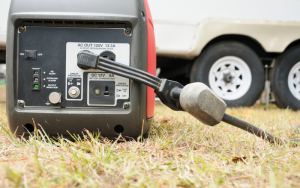
Buying a Generator for RV Life

RV Refrigerators: How Do They Work?

How to Repair Norcold Fridge Flap

How To Troubleshoot The Thermistor On Your RV Refrigerator

Propane RV Fridge and RV Driving: How Dangerous Is It? (Explained)

How To Install A Residential Refrigerator In An RV (Securely)

1 thought on “How Do Sway Bars Work? (Do You REALLY Need Them?)”
A variety of factors might cause an RV to swing or sway while driving. Crosswinds are the most prevalent culprit, which might occur naturally or as you slow down your driving. If you’re concerned about your safety, a sway bar should be installed on your vehicle to prevent it from swaying or swinging while you’re driving.
Leave a Comment Cancel reply
Recently published guides.

- You are here:
- Home »
- Blog »
- » How to Install Travel Trailer Sway Bars (8 Adjustment Tips)
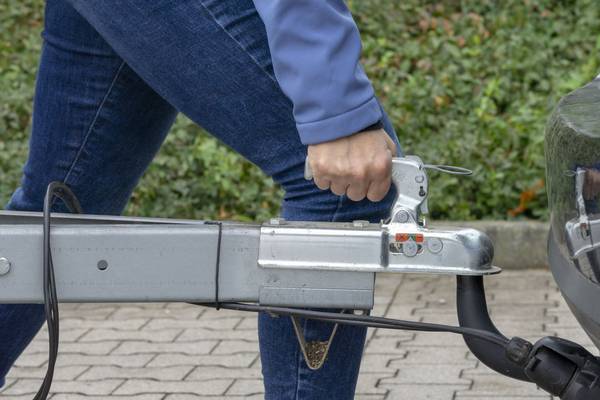
How to Install Travel Trailer Sway Bars (8 Adjustment Tips)
- October 25, 2019 /
- RV Towing /
- By James V.
are protected by using the right anti-sway bars.
Installing the sway bar is simple to do, but it also depends on location. You can install the sway bar near the hitch ball but you want it to be 1 ½ forward and 5 ½ inches outward from the hitch ball. Keep the sway bar centered to the hitch ball.
That was just the first step in installing the sway bar. To find out the rest of the steps just continue to read our article. It lets you know how to install a sway bar and gives you some adjustment tips
Not all sway bars are made the same and some do not work with those trailers that have surge brakes. The sway bars work on specific hitches and weight limits only.
Tip 2 : Do a fully loaded test drive at normal towing speeds. Monitor your trailer's actions and when you stop, you need to locate the tension screws. Once you have done that, you can turn the ¼ to increase or decrease the tension. Your test drive should tell you which way you need to turn that tension screw.
How to Install Travel Trailer Sway Bars
the sway ball is centered on the hitch bar. Then attach the ball 1 ½ inches forward and 5 ½ inches outward from the hitch ball.
is done use a rag and grease the threads of the handle, so it moves easily for you.
Step three, make sure the sway bar is parallel to the body of the car and about 4 ½ inches away from the car. Tighten the bolts and attach the bar coupler to the ball.
go and ready for your road trip.
an adjustment .
Travel Trailer Anti-Sway bar Installation Tips
Here are some steps to help you install your sway bar correctly and avoid road problems when you are away from home.
- 1 . Raise your vehicle-make sure to get it high enough off the ground to work safely on it.
- 2 . Now you remove the end links.
- 3 . Next, you need to remove the 2 supporting bolts holding the muffler to your car. Slide the muffler out of your way.
- 4 . Next, remove the bolts holding the sway bar bushing strap. There are two on each side butmake sure to remember their orientation. You need to recreate it later.
- 5 . Maneuver the sway bar around the exhaust on the passenger side and add some grease to lubricate the bushings.
- 6 . Now you have to remove the bolts from the subframe and slide the reinforcement in the middle of the subframe and chassis. Don’t forget to support the differential housing at the same time.
- 7 . Install the bracketat this time with the concave design pointing towards the rear. Then move the sway barbushing strap and align it with the holes. Torque should be 35 pounds on the smaller bolts and 100 on the larger.
- 8 . Put the end links back on and remove the subframe brace.
- 9 . Keeping the sway bar supported remove thebushing straps, attach the end links to the sway bar and install the sway bar making sure nothingis put in upside down.
- 1 0 . Attach the front end links and put the bushing brace back on. 40 and 55 pounds of torque, respectively.
adjustment process again
How to Adjust Travel Trailer Sway Bars
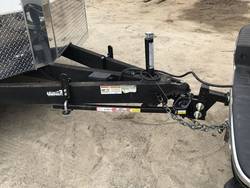
adjustment screws that need a little turn, either way, to make sure you have the right tension on your trailer.
you should do a test drive with your tow vehicle and your trailer filled with the same weight you will have on your trip. Travel at the same speeds you would normally travel at to make sure you get the best reading possible.
Once you have returned from your test drive, turn the screws about ¼ in the way you need to make the turn. This will increase or decrease the tension on your trailer and make it safer for the road.
Keep making test runs till you get the right amount of tension.
all sway bars are not made the same and there is no one size fits all device. Get the right sway bar for your trailer’s size and weight.
Travel Trailer Sway Bar adjustment Tips
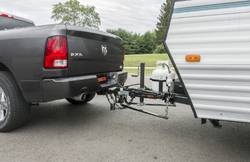
is gained by rushing through this procedure. Also, make sure you know which direction you need to turn to increase or decrease the tension.
adjustment process. It will also make your trailer unsafe and you will probably continue to have swaying issues affect your driving.
adjustment where it should be.
Tip 6 : depending on your sway bar design and model type, sometimes all you have to do is turn the handle to add or subtract friction. You turn the handle till you get the right balance of friction for both the tow vehicle and the trailer.
Travel Trailer Sway Bar Noise
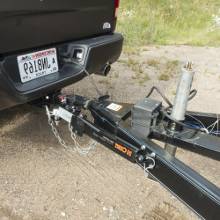
noise . It is just the nature of the beast. Some experienced RV owners get embarrassed by the noise one brand makes but there is nothing they can do about it.
you should take the tension off before you do that.
A homemade answer is to turn to a little petroleum jelly. This helps reduce the friction noise without interfering with the sway bar’s job.
Generally, their main purpose is to stop a vehicle’s lean. All the stiffness does is reduce the amount of the lean your vehicle experiences when it comes face to face with sway sources.
Travel Trailer Hitch and Sway Bars
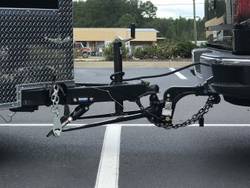
better and should be able to withstand those sway causing elements a lot easier.
One rule of thumb to help guide you would be that if your trailer GWR is 50% greater than your GVWR on your tow vehicle, then you would need to use a weight-distribution bar.
are generally made for small tongue trailers
effectively, is managing your tongue weight. Make sure your tongue weight remains between 12 and 15 percent and your sway bar should not have as much trouble.
Hooking up Travel Trailer With Sway Bars
Here is one way to hook up your travel trailer when it already has a sway bar attached and in position.
Firs t , back your tow vehicle into position.
Second , lower the hitch tongue till it is almost at rest on the ball.
Third , insert weight distribution bars into the receivers on the hitch, pulling them tight on the trailer tongue. Once done, just lower the tongue until it rests on the ball.
Finally , just reconnect the sway bar and you should be ready for the road.
it can be dangerous to attach your trailer to the hitch ball if you do not know what you are doing. If you make the wrong move, you could be seriously injured.
So, make sure you get instructions and a demonstration to help you avoid an injury to yourself.
How to Unhitch a Travel Trailer With Sway Bars
limited number of models.
Then be careful when you do it, trailer tongues and other vehicle parts are heavy and can cause a lot of damage. Here are those instructions for you:
position to lift the tongue.
starts to move up from the lack of weight.
be driven away safely.
the process is completed .
Some Final Words
is not going to be that difficult. You just need to know what you are doing. If you don’t get qualified help or go to your dealer and let them install it for you.
adjustment screws so you know which way to turn to increase or decrease the tension. Remember, each sway bar is different, and they do not work for every trailer.
Know the details of your tow vehicle and trailer and find the right sway bar for both. Also, be careful. These are some risks involved when attaching or unhooking your trailer with a sway bar attached.
Related Posts
Can You Put a Weight Distribution Hitch On a Lifted Truck?
Can a 1500 Pull a 5th Wheel? (Half-Ton Ram, Sierra, Silverado)
What Is The Towing Capacity of a Thor? (Majestic, Ace, Axis)
Leave a Comment:

Ask The RV Engineer
11 causes of trailer sway and how to stop it – myths vs facts.
Trailer sway is the stuff of nightmares. It’s a classic case of the tail wagging the dog. It’s the number one cause of RV accidents in this country.
If you’re the sort of person who can’t help but rubberneck when driving past a car crash, there’s no shortage of nail-biting trailer sway footage on YouTube. Here’s one I curated for your horrified enjoyment:
Now that I’ve made your palms a little sweaty, let’s make sure you stay on the correct side of a dashcam recording.
What Is RV Trailer Sway?
Trailer sway is also known as fishtailing or whipping. It’s a persistent side-to-side swaying motion, usually at higher speeds.
The cause is when the trailer is moving faster than the tow vehicle. This manifests itself as a side-to-side oscillation of the trailer. This can be due to crosswinds, uneven roads, steep mountain roads, insufficient tongue weight, or evasive driving maneuvers. I’ll talk more about common causes of trailer sway below.
Trailer sway is insidious because it’s so difficult to predict. Under some circumstances, a swaying trailer will quickly re-align with the tow vehicle. In others, a swaying trailer will continue to sway in increasing oscillations until it completely overwhelms the tow vehicle and BOOM! – crash! This can happen in a matter of seconds.
Do All RVs Have Trailer Sway?
No, not all RVs are subject to trailer sway. It only affects towable RVs (although motorhomes can have their own sway problems!). And because 5th wheels pivot directly atop, not behind, the rear axle, the trailer sway problem mostly affects travel trailers – which just so happen to be the most popular kind of RV!
Trailer sway has literally caused RV owners to quit the lifestyle because they’re so terrified of losing control. It’s a serious problem if you’ve never towed an RV before .
(This is one reason why practically no other country allows drivers without a special permit to tow something so large and so heavy.)
As American RV owners, we enjoy unparalleled, unfettered access to public highways and larger-than-life RVs. That’s a privilege not to be taken lightly. Your safety – and the safety of those around you – depends on it.
If you intend on towing a 7,000-lb mini-house, you need to learn how to mitigate and eliminate trailer sway.
11 Common Causes of Trailer Sway
1. insufficient tongue weight.
One of the most common causes of trailer sway, particularly for travel trailers, is insufficient tongue weight. Tongue weight must be at least 10-15% of the gross trailer weight for travel trailers, and 15-25% for fifth wheels.
You should always weigh your camper trailer before every trip to determine proper gross trailer weight and tongue weight. If you haven’t weighed your camper, assume tongue weight should be 10-15% of the GVWR. That is the more conservative option.
Without sufficient tongue weight, this can happen:
2. Poor Weight Distribution Adjustment
If your WDH isn’t set up correctly, it can be returning too much weight to the tow vehicle’s front axle and the trailer’s rear axle. This effectively reduces tongue weight and, even worse, reduces traction on the tow vehicle’s rear axle.
You also want to centralize the weight distribution of your camper. Tongue weight is not the be-all-end-all. The distribution of mass matters as well. Keep the heaviest loads close to the trailer’s axle (preferably just in front of it), and avoid stashing heavy loads near the ends of the RV (this includes full water tanks, too).
3. Stiff Crosswinds
If you’ve ever driven across Wyoming, you’re familiar with wind’s incredible power. The broad, flat side of your towable RV is nothing but a sail. C rosswinds will attempt to push your RV right off the road – but it’s coupled to your tow vehicle with a coupler or 5th wheel hitch, a rotating pivot point.
And if we go back to high school science, we realize that this is a classic lever-and-fulcrum situation. Your RV has become a multi-thousand-pound lever trying to pry and spin your tow vehicle out of alignment. The trailer applies a steering torque to your tow vehicle.
Do not drive in stiff crosswinds. Listen to the DOT. No amount of careful driving can save you from a hellbent crosswind.
4. Semi-Truck Gusts
I used to ride a Honda Rebel 250cc motorcycle (not much bigger than a dirtbike) down the Interstate. I rode at wide-open throttle every mile – out of safety! I couldn’t let a semi-truck pass me trundling along at 50 mph; the crosswinds alone could rip me out of the saddle!
Give semi trucks a wide berth as they pass you. They create a powerful bow wave and vacuum vortex that will blow you out and then suck you back in a few seconds later. It’s very disorienting.
5. Too Small a Tow Vehicle
There. I said it. I said what your RV salesman won’t!
Ok, so here’s what I mean. Does a smaller or shorter tow vehicle cause trailer sway? No, not technically … but once a trailer starts swaying, it’s up to your tow vehicle to resist it. And a lightweight, short-wheelbase SUV just can’t handle the fishtailing of a massive RV.
There are three design geometries you want to watch out for:
- What’s the tow vehicle wheelbase? In other words, how far apart are the front and rear axles? The longer, the better! It’s like the difference between a sea kayak and a whitewater kayak.
- What’s the tow vehicle rear overhang? The farther away the tow vehicle hitch from the rear axle, the more susceptible the vehicle will be to the effects of trailer sway. Hitch extenders are bad for this same reason.
- What’s the tow vehicle weight? Ceteris paribus, a heavier tow vehicle will always resist trailer sway more than a lighter one. A tiny tail can’t wag a giant dog!
- (Bonus) What’s the width (track) of the tow vehicle? Generally, a wider tow vehicle, such as a dually truck, will tow with much more stability than a narrower vehicle, like a crossover SUV.
We’ve barely scratched the surface of this topic. In fact, we’ve barely scratched the surface of trailer sway! For more information, check out one of my favorite YouTubers and his video on 10 causes of trailer sway:
6. Underinflated Tires
Underinflated tires are squishy tires, where the sidewalls can bow and compress like springs. Inflate your tires to the correct pressure!
7. Evasive Driving Maneuvers
The last time I hit a chipmunk while driving, I almost cried. I hate needlessly killing animals. But if I’m towing a trailer, chipmunks and turtles had better get out of my way, because I’m not swerving!
When towing an RV camper trailer, avoid quick changes of direction.
- Merge slowly
- Turn early and turn wide
- Crawl around hairpin turns
- Drive like Grandma
- Follow the 3-Second distance rule
8. Potholes and Rough Roads
Anything that pushes your RV sideways can cause trailer sway. Potholes, rumble strips, asphalt cracks, and other road imperfections can all cause sideways forces.
Your solution to rough roads is simple: Reduce your speed. This is particularly important in construction zones, where clearance is minimal, and any trailer sway could become catastrophic.
9. Rain, Ice, and Snow
If your trailer tires lose traction, the trailer may begin to slide or slip due to its own weight. Here’s a guide to driving in RV in winter weather conditions.
10. High Speeds
A full explanation of why increased speed amplifies trailer sway is beyond the scope of this guide. People much smarter than me have composed full dissertations in differential equations on the physics of this matter. According to ProPride, s peeds above 45 mph tend to create trailer sway in any trailer! Physics dictates that every trailer-tow vehicle combination will sway at some speed, and the threshold can be immediate. Just increasing your speed by 5 mph can have drastic effects.
Here’s a Changing Gears guide to how fast you should really be driving your RV.
11. Driving Downhill

Towing downhill can cause your trailer to roll faster than your tow vehicle – especially if your trailer brakes are old and worn out. When your trailer wants to move faster than your tow vehicle, it will begin to yaw (sway) to one side.
Bonus: NOT Weight
Did you notice what’s not on this list? Weight!
That’s right – the total weight of your RV doesn’t usually factor into the cause of trailer sway. With that said … the full answer is a little more complicated.
- Because while a lighter RV may not be less susceptible to trailer sway, a lighter camper is less likely to overwhelm your tow vehicle once it starts swaying.
- And a lighter camper of the same length and height as a heavier camper will respond more quickly to sideways forces.
So while weight doesn’t cause trailer sway, it does affect the aftermath, as a larger RV relative to the tow vehicle is liable to overwhelm the tow vehicle.
How to Stop Trailer Sway
Step 1: let off the gas pedal to reduce speed.
Resist the instinct to stomp on the brake pedal. Without getting too technical, what usually happens is your tow vehicle stops “faster” than your trailer, which means your trailer wants to accelerate into your tow vehicle – and if it’s off balance, that’s exactly what it’ll do.
If you’re going downhill, apply light pressure to the brake pedal to gradually and safely slow down.
Now, some people suggest slightly increasing your speed to reduce trailer sway. This is because accelerating the tow vehicle naturally tries to bring the trailer into alignment and equalizes their speeds. If, for instance, your trailer gets knocked off course by a pothole, a slight acceleration can bring the trailer to heel.
But don’t do this!!
Because your panicky human brain isn’t a supercomputer than can calculate the exact cause of trailer sway. Because if you’re wrong, and the trailer sway is due to improper loading or sideways forces, then you’re just adding fuel to the fire. You’ll only amplify the oscillations and increase the risk of an all-out high-speed rollover crash.
Step 2: Keep the Steering Wheel Straight
Don’t oversteer. Keep the wheel straight, even if the tow vehicle begins spinning left or right. Cranking the wheel back and forth will only amplify the problem.
Step 3: Manually Activate the Trailer Brakes
If possible, manually activate the trailer brakes from the trailer brake controller. Most of the time, your trailer brakes are activated when you push on the brake pedal (and in the case of a proportional brake controller , are linked to the intensity of the push as well). Since you don’t want to stomp on your brake pedal, you’ll need to activate the trailer brakes manually.
Step 4: Pull Over at a Safe Place
Congrats – you didn’t become a statistic!
But you need to sleuth out what went wrong. Is the camper loaded improperly? Were you driving too fast? Are the crosswinds too strong? Do you need to adjust the friction on your anti-sway bars?
Take your time. Your life is literally on the line!
You Are Towing With a Weight-Distribution Hitch, Right?
Look, I get it. As an RVer, you’re drowning in gadgets. Do you really need on more? One that costs several hundred dollars?
Yes, you do. I’m not a “retail therapy” kind of guy, but if you’re towing a heavy travel trailer, a weight-distributing anti-sway hitch is mandatory. Forget all the myths and misconceptions about WDHs; you need one!

Essentially, an anti-sway hitch either dampens the sway or locks/extends the pivot point. Now your tow vehicle and trailer move as one.
This is not a what’s-the-best-weight-distribution-hitch review article. But I do want to quickly break down your options into three categories:
The Good: Friction Control
Your typical entry- to mid-level weight-distribution hitch, like a basic Reese, Curt, or Husky, uses an adjustable friction pad to dampen sway. Details vary by manufacturer, but they all work more or less the same way. You can adjust the amount of friction depending on your setup and road conditions.
There’s nothing inherently wrong with an anti-sway friction control bar. But they don’t really eliminate the problem; they just mitigate it. If you put a lot of miles on your RV, or you’re towing with a marginal TT/TV combination (aka, short-wheelbase SUV), then you can do better.
The Better: Variable Resistance
Now we’re looking at something like the Blue Ox SwayPro, the Andersen No-Sway WDH, or the Equal-I-Zer. All great hitches, and t hey all employ some clever mechanism that can modulate the resistance to lateral swaying. Many experienced RVers soon upgrade to one of these hitches.
The Best: Lock It Out!
The two big names in premium travel trailer hitches are Hensley and ProPride 3P hitch. Of these two, the ProPride 3P hitch has a reputation for being easier to use.
I haven’t used either one. But they’ve achieved near cult-level status. Airstream owners, in particular, seem to go absolutely ga-ga over the ProPride 3P hitch.
Yes, they’re expensive: $2,000+. But buy once; cry once!
There’s no perfect hitch – not even a ProPride 3P. If you’re limited to 500 lbs hitch weight, for instance, you might not be able to afford the weight of a ProPride. You might be better off with a lightweight Andersen WDH, which is one of my favorites. Just don’t wait for an accident to make your decision for you.
4 responses to “11 Causes of Trailer Sway and How to Stop It – Myths Vs Facts”
The ball on my antisway hitch is positioned 6.5 inches farther behind my receiver than my standard hitch that I use for small trailers. Is there a reason for this? I could easily move my antisway hitch closer to my reciever (and rear axle) 2 inches or more. Would this be a mistake?
As long as you don’t run into clearance or interference issues (such as when taking sharp turns), it is recommended to keep the hitch overhang as minimal as possible. So if you can move the hitch 2″ closer to your rear axle, do it! 🙂
In terms of performance, is a chain WDH or a bar WDH superior? Or is that even the right question?
That’s a difficult question to answer, Karl! Different pros and cons of both: different setup times, weight ranges, ease of backing up, etc. Sometimes the construction of the travel trailer tongue and coupler makes a big difference, since some types of couplers aren’t approved for use with chain (Andersen) weight-distribution hitches. There’s nothing wrong with either one as long as they’re set up properly.
Leave a Reply Cancel reply
Your email address will not be published. Required fields are marked *
- (856) 697-4497
What You Need To Know About Sway Bars for Campers
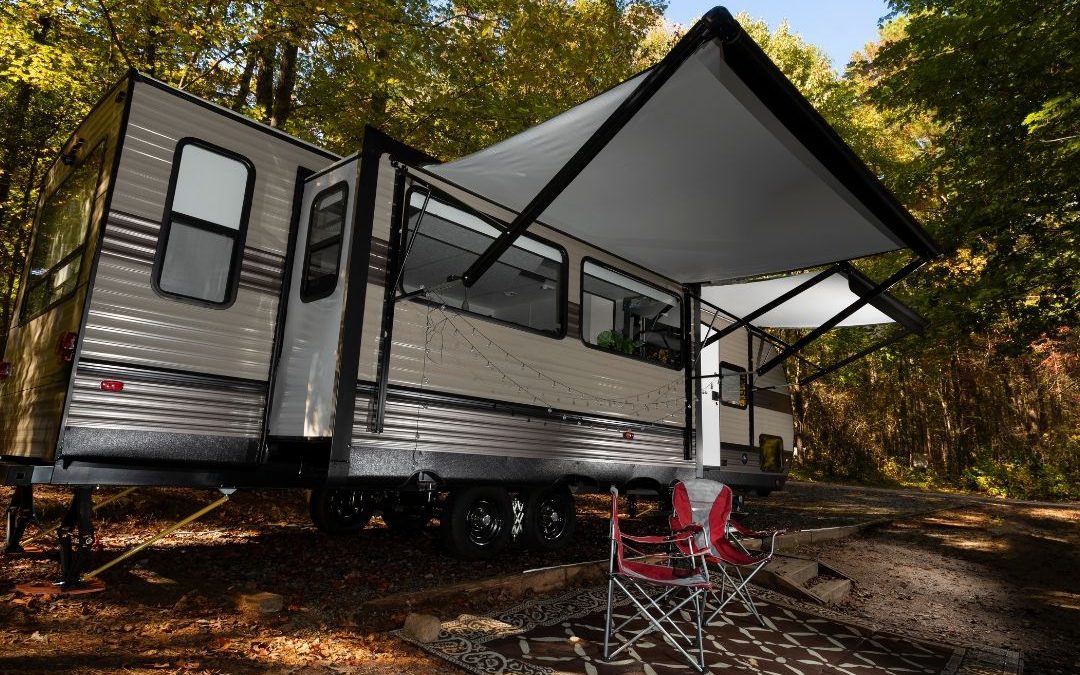
Rving is one of the most freeing experiences in the world. Once you’ve got the right tow vehicle and camper, you just want to get out on the open road. But there are a few pieces of safety equipment that you need to look over first. One important item is the sway bar, which is common in many towable RVs. But do you really need a sway bar for your camper, or is it just one more unnecessary accessory?
RVers everywhere dread sway. Luckily, you can significantly reduce trailer sway with the addition of a sway bar for your camper. Let’s take a deeper look at sway: what it is, what causes it, and how you can prevent it.
When it comes to RVing, sway is best saved for the hammock. Feeling your travel trailer sway from a gust of wind is scary, but there are products and strategies that can help reduce sway and keep your RV aligned.
Shop The Best Deals on RVs
So what is sway anyways.
You can experience sway when driving any vehicle, not just a camper. When referring to vehicle sway we are talking about side to side body roll
Camper sway is when the trailer starts to swing side-to-side behind the tow vehicle, usually while you’re going down a highway. Trailer sway can become dangerous and uncontrollable if not managed. It can even lead to accidents.
The most common causes of sway are gusts of wind, drafts from passing semi-trucks, turns on curvy roads, and imbalanced loads in the trailer. Even a small amount of sway can be exhausting for a driver, forcing constant steering adjustments. Weight distribution and sway prevention systems make for a safer and smoother ride.
Your content goes here. Edit or remove this text inline or in the module Content settings. You can also style every aspect of this content in the module Design settings and even apply custom CSS to this text in the module Advanced settings.
So what causes sway? Trailer sway has several causes: Improper weight distribution, driving too fast, and wind gusts or bursts of wind from other large vehicles like RVs or semi-trucks.
If you want to stop your travel trailer from swaying when you are going down the road, then a sway bar is probably going to be the best accessory that you can invest in for your new camper.

So What is a Sway Bar?
A sway bar is simply a device that stiffens side-to-side motion to minimize it. They can be installed on vehicles to minimize body roll or on hitches to minimize camper sway.
Sway bars are important pieces of safety equipment for RVs. They help prevent swaying on the highway and they can even save your vehicle from a dangerous crash or rollover. Some drivers find that sway bars make it harder to turn, but overall, the extra safety is worth it. Most campers on the market today come with sway bars pre-installed, so you don’t need to worry too much about seeking one out.
Camper sway bars come in a couple of different forms, but they all serve the same purpose. The two main types are hitch sway bars and adjustable sway bars.
Hitch sway bars are made with a pair of sturdy metal arms that connect the trailer to the hitch of the tow vehicle. With this model, the sway bar is built directly into the weight distribution hitch with no need for extra add-ons. Sometimes chains or adjustable bars are added for greater control or flexibility.
Adjustable sway bars are a bit less common these days, but they are still good pieces of equipment. The adjustable type of sway bar connects directly to the tongue of the trailer and the hitch of the tow vehicle. It is a solid bar that can lock into place at whatever length you choose. When you’re traveling on the highway and experience rough conditions, this bar will stay steady and prevent the trailer from moving closer or further from the tow vehicle.

So Do I need a Sway Bar for my Camper?
Fifth-wheels do not need sway bars. One of the major benefits of a fifth wheel is the way it pulls from over the axle it is much more stable. Travel trailers however can benefit greatly from a sway control hitch.
Many modern travel trailers are built with weight distribution hitches and they have sway bars that are already attached. Sway control or sway bar hitches are optional pieces of equipment that you can add to your camper or hitch to prevent sway. Although they’re not required, adding a sway bar will provide a much more comfortable and stable towing experience and give you peace of mind.
Recent Posts
- Tips for Washing a Camper Exterior
- 10 Best Places for Spring Camping in New Jersey
- Smart Shopper’s Checklist: Top Tips for Buying a Used RV
- RV Fire Safety Tips
- Hit the Road with Confidence: A Guide to Replacing Your RV Tires
- Featured Brand
- Featured Units
- Horses and Trailers
- RV Lifestyle
- Tips and Tricks
- Travel Destinations
New On The Lot
- Sway Bars for travel trailers
The Best Sway Bars for Travel Trailers: Reviews and Buying Guide
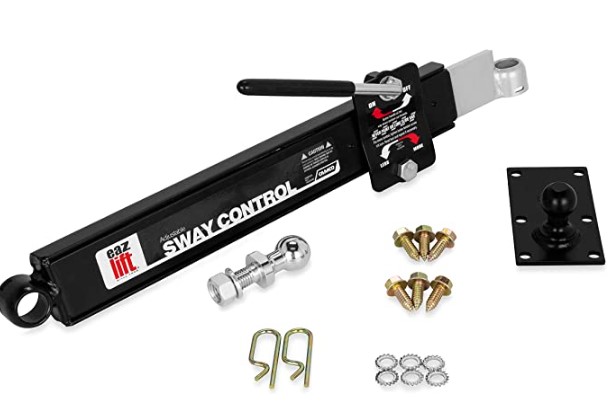
If you've ever taken a road trip with a travel trailer, you know how important it is to have a stable and secure rig. Unfortunately, even the most well-built trailers can experience swaying and rocking while on the road, which can be uncomfortable and even dangerous. That's where sway bars come in.
Sway bars, also known as anti-sway bars or stability bars, are designed to improve the stability and handling of your trailer by reducing lateral movement. They work by transferring weight from one side of the trailer to the other, helping to counteract the forces that cause swaying and rocking.
In this article, I'll review the top sway bars for travel trailers on the market. I'll cover everything you need to know, including how sway bars work, the different types available, and the key features to consider when choosing the best sway bar for your needs.
What are Sway Bars and How Do They Work?
Sway bars are essentially long, sturdy rods that are attached to the trailer's suspension system. They're designed to improve stability and handling by reducing lateral movement and swaying.
When a trailer is being towed, lateral forces are exerted on the trailer's suspension system, causing it to sway and rock from side to side. These forces can be caused by a variety of factors, including wind, uneven road surfaces, and the weight distribution of the trailer itself.
Sway bars work by transferring weight from one side of the trailer to the other, helping to counterbalance these forces and reduce swaying. They do this by using a combination of torsion and compression, which helps to keep the trailer more stable and secure while on the road.
Different Types of Sway Bars
There are two main types of sway bars available for travel trailers: weight-distributing sway bars and friction sway bars.
Weight-Distributing Sway Bars
Weight-distributing sway bars are the most common type of sway bar used for travel trailers. They work by distributing the weight of the trailer evenly across the tow vehicle's axles, helping to reduce swaying and improve stability.
These sway bars typically use a spring-loaded mechanism to transfer weight from one side of the trailer to the other. They're typically more effective at reducing swaying than friction sway bars, but they can be more expensive and require more maintenance.
Friction Sway Bars
Friction sway bars are another type of sway bar that can be used for travel trailers. These sway bars use a friction pad to transfer weight from one side of the trailer to the other, helping to reduce swaying and improve stability.
Friction sway bars are generally less expensive and easier to install than weight-distributing sway bars, but they may not be as effective at reducing swaying. They also require more maintenance, as the friction pad needs to be replaced periodically.
Key Features to Consider When Choosing a Sway Bar
When shopping for a sway bar for your travel trailer, there are a few key features to consider:
- Compatibility: Make sure the sway bar you choose is compatible with your specific tow vehicle and trailer. Different sway bars have different weight limits and mounting points, so it's important to get the right one for your setup.
Weight capacity: Pay attention to the weight capacity of the sway bar you're considering. It's important to get a sway bar that can handle the weight of your trailer, as using a sway bar that's too small could be dangerous.
Adjustability: Some sway bars are adjustable, which can be useful if you want to fine-tune the level of sway control or if you have a trailer with a particularly high or low center of gravity.
Durability: Look for sway bars that are made from high-quality materials and are built to last. You want a sway bar that can withstand the rigors of the road and won't break or wear out quickly.
Ease of installation: Consider how easy the sway bar is to install. Some sway bars can be difficult to install, especially if you're not particularly handy. If you're not comfortable installing the sway bar yourself, you may want to look for one that's easier to install or consider hiring a professional to do the job.
The Top Sway Bars for Travel Trailers: Reviews and Comparison
Curt 17200 trailer anti-sway bar control kit , black.
The CURT 17200 Trailer Anti-Sway Bar Control Kit is a simple yet effective way to improve the control of your trailer. This kit helps to limit the lateral movement of your trailer, using a brake pad type material to restrict and deter trailer sway.
This versatile sway bar is compatible with a wide variety of weight distribution hitches, including almost all CURT weight distribution hitches, and can be used on most A-frame trailers. It is highly adjustable, using a simple hex nut toggle to adjust the level of trailer sway restriction for different trailer types and load sizes.
Setting up this trailer sway control unit is fast and easy, with the included trailer balls mounted in place and an on-off handle that makes it easy to engage or disengage the sway control whenever needed. The complete kit includes everything needed for installation on your camper or RV as well as your weight distribution hitch or sway tab ball mount.
- Improves control of trailer.
- Versatile and compatible with many weight distribution hitches and trailer types.
- Highly adjustable.
- Easy to set up and use..
- Complete kit includes everything needed for installation.
- May not be as effective for larger trailers or those with heavier loads.
- Some users may find it difficult to adjust the hex nut toggle to their desired level of sway restriction.
- May not be compatible with all weight distribution hitches or trailers.
- Some users may prefer a more permanent or automated sway control solution.
XtremepowerUS Heavy Duty Weight Distribution Equalizer Trailer Sway Control Towing Hitch Bar 1,000lbs 2-Inch Shank
The XtremepowerUS Heavy Duty Weight Distribution Equalizer Trailer Sway Control Towing Hitch Bar is a top-rated sway bar designed to improve the stability and handling of your travel trailer. With a weight capacity of 1,000 lbs and a maximum weight capacity system of 10,000 lbs, this sway bar is suitable for a wide range of trailers.
One of the standout features of the XtremepowerUS Heavy Duty Weight Distribution Equalizer Trailer Sway Control Towing Hitch Bar is its durable steel construction. It's built to last and can withstand the rigors of the road.
This sway bar is also easy to install, with a 2" shank and pre-installed brackets and hardware. It comes in a sleek black finish and is easy to attach to your tow vehicle.
- Durable steel construction
- High weight capacity (1,000 lbs)
- Easy to install with pre-installed brackets and hardware
- Some users may find it heavy (83.1 lbs)
- Assemble required
Overall, the XtremepowerUS Heavy Duty Weight Distribution Equalizer Trailer Sway Control Towing Hitch Bar is a reliable and effective sway bar that's well considering if you're looking to improve the stability and handling of your travel trailer. Its durable construction and high weight capacity make it suitable for a wide range of trailers, and it's easy to install with pre-installed brackets and hardware.
Reese Integrated Sway Control Weight Distribution Kit
With a weight capacity of 12,000 lbs and a 2-1/2" hitch and 5" rise, 4" drop, this sway bar is suitable for a wide range of trailers and can help to reduce swaying and improve stability while on the road.
One of the standout features of the Shocker Air Equalizer & Sway Control Kit is its innovative design. It uses air shocks to absorb road shock and reduce swaying, providing a smooth and comfortable ride for both the trailer and the tow vehicle.
This sway bar is also easy to install, with a no-drill, clamp-on design that fits up to 7" trailer frames. It's finished with a durable powder coat to protect against rust and other types of wear and tear.
- Innovative air shock design for improved ride comfort and sway control
- Easy to install with no-drill, clamp-on design
- High weight capacity (12,000 lbs)
- Durable construction with powder coat finish
- Some users may find it expensive
Pro Series 83660 Value Friction Sway Control, Regular
This sway bar uses friction to resist pivotal movement and work against the effects of induced sway, helping to reduce swaying and improve stability while on the road.
One of the standout features of the Pro Series 83660 Value Friction Sway Control is its simplicity. It operates on a simple, uncomplicated principle and is easy to adjust to suit various trailer weights and towing conditions. It includes a sway control ball and mounting hardware for easy installation.
This sway bar is suitable for use with A and C trailer tongues, but it cannot adapt to a pole tongue trailer frame. It's not recommended for use with surge brakes.
- Budget-friendly option
- Easy to adjust to suit various trailer weights and towing conditions
- Includes sway control ball and mounting hardware
- May not be as effective as weight-distributing sway bars
- Not suitable for use with surge brakes or pole tongue trailer frames
Hellwig 7643 Rear Sway Bar
With a weight capacity of 26 pounds and a sleek smooth exterior, this sway bar is suitable for a wide range of vehicles and can help to reduce swaying and improve stability while on the road.
One of the standout features of the Hellwig 7643 Rear Sway Bar is its easy bolt-on installation. It comes with high-tech polyurethane bushings and is engineered and developed for your specific application, making it easy to install and ensuring a perfect fit.
This sway bar is also built to last, with a high-quality 4140 chrome moly spring steel construction. It's backed by a lifetime warranty, so you can have peace of mind knowing that it's built to last.
- Easy bo t-on installation with high-tech polyurethane bushings
- High-quality 4140 chrome moly spring steel construction
- Lifetime warranty
- Suitable for a wide range of vehicles
- Some users may find it heavy (26 lbs)
- Not adjustable

Stay updated with our newsletter
Images provided by: depositphotos.com
In conclusion, sway bars are an essential component for improving the stability and handling of your RV. They work by transferring weight from one side of the trailer to the other, helping to reduce swaying and improve stability. There are many different sway bars on the market, each with its own unique features and capabilities.
When shopping for a sway bar, it's important to consider factors such as weight capacity, adjustability, durability, and ease of installation. It's also a good idea to read reviews and compare different sway bars to find the one that's best suited to your specific needs.
Some of the top sway bars for RVs include the Equal-i-zer Hitch Sway Control, the Reese Strait-Line Hitch Sway Control, and the Fastway e2 Weight Distributing Hitch Sway Control. These sway bars are all designed to work with a variety of tow vehicles and trailers and offer excellent sway control, durability, and ease of installation.
Ultimately, the best sway bar for your RV will depend on your specific needs and preferences. By considering the factors mentioned above and doing your research, you can find a sway bar that will help to improve the stability and handling of your RV and provide a safer, more comfortable ride.
About Author:

Hi, I'm Kevin Pommells, a lover of camping and the great outdoors as everyone says nowadays. I'm also a passionate soccer fan and the proud owner of CamperRules.com, a website dedicated to helping campers and outdoor enthusiasts make the most of their adventures. With years of experience exploring the wilderness and a deep love for the sport of soccer, I'm always looking for new ways to combine my two passions and share my knowledge with others. Follow me for tips, tricks, and insights on all things camping and outdoor recreation.
Follow Me @ Twitter | Facebook | KevinPommells.com
As an Amazon Associate I earn from qualifying purchases.
We are a participant in the Amazon Services LLC Associates Program, an affiliate advertising program designed to provide a means for us to earn fees by linking to Amazon.com and affiliated sites.

IMAGES
VIDEO
COMMENTS
A Simple Guide. Adding a travel trailer to the back of any vehicle definitely raises some safety questions. Specifically, if you should have a sway bar or not, to prevent dangerous rollovers. For first time drivers, it can be confusing to know what safety precautions you should be taking since there's a lot of information to absorb.
Trailer sway bars are essentially control bars for trailers that stiffen the side-to-side motion in an effort to minimize it, making them very important pieces of equipment for towing a travel trailer or any type of trailer. (Note that 5th wheels tend to be much more stable than other travel trailers and don't usually require the addition of ...
Trailer sway bars are bars that attach to and provide an additional connection point between the tow hitch and the tongue of the trailer that reduces and dampens trailer sway through friction. There's a lot more to know about trailer sway bars though than just their basic purpose. So if you're thinking about purchasing trailer sway bars or ...
Not all trailers benefit from a anti sway bar. In fact, fifth-wheel trailers don't need sway bars as the way it pulls from over the axle is much more stable. However, most travel trailers will benefit from using a sway control hitch. Sway bar hitches are optional pieces of equipment that can be added to your travel trailer or camper hitch to ...
Wear and Tear. One main reason why some rig owners do not like having a sway bar is that it may cause more damage to your car. If you have a sway bar installed, it will block your car's suspension and may lead to more damages in the future. 2. Additional Expense.
Don't panic. Slow and steady steering will help straighten your trailer and tow vehicle. Don't attempt to counter-steer, as this can cause the sway to get worse and make you lose control. Don't brake the towing vehicle. Instead, brake the towed RV very slowly, using your auxiliary brake's manual override.
Definition of an RV Sway Bar. Sway bars are crucial components of an RV's safety system. They aid in preventing swaying when driving on the highway and may potentially prevent a dangerous collision or accident when towing your trailer with your car. Sway bars can make turning more difficult for some drivers, but the added safety is often ...
However, for trailers or campers, a sway bar (or sway controller) is part of a trailer or camper's hitch setup, not part of the suspension system. The sway bar is an adjustable bar with a friction plate that attaches to points on the hitch and trailer and works to reduce the trailer's ability to swing or sway behind your vehicle as you drive.
Do I Need a Sway Bar for My Trailer? Understanding the Role of Sway Bars in Trailer Stability Sway bars, essential tools in the towing arena, enhance control and safety by mitigating the lateral movement of trailers. During towing, various factors like wind, road irregularities, and passing vehicles can induce a pendulum-like motion. The response? Sway bars. Their purpose is straightforward ...
If you feel your trailer start to sway DO NOT react impulsively and steer the wheel rapidly in the opposite direction. 1. Keep the Wheel Straight. If you try to steer out of the sway, your sudden movement will only increase the problem. You will almost certainly cause your travel trailer to fishtail more.
Do I Need a Sway Bar for My Travel Trailer? the answer is have because even if you observe preventive measures, there is always the risk of unknown forces causing your travel trailer to roll. Having a stabilizer bar under your travel trailer's chassis can minimize the threat of sway and improve road safety. A sway bar for travel trailer is an ...
Tip 1: One of the first things you need to do is get a set of sway bars that fit your trailer. Not all sway bars are made the same and some do not work with those trailers that have surge brakes. The sway bars work on specific hitches and weight limits only. Tip 2: Do a fully loaded test drive at normal towing speeds.
A sway bar for travel trailer is an aftermarket accessory that RV owners install in their travel trailer's suspension to improve its handling characteristics. The add-on is an extended steel bar with a U-shaped center section to accommodate the travel trailer's under-chassis components.
1. Insufficient Tongue Weight. One of the most common causes of trailer sway, particularly for travel trailers, is insufficient tongue weight. Tongue weight must be at least 10-15% of the gross trailer weight for travel trailers, and 15-25% for fifth wheels. You should always weigh your camper trailer before every trip to determine proper gross ...
A sway bar is simply a device that stiffens side-to-side motion to minimize it. They can be installed on vehicles to minimize body roll or on hitches to minimize camper sway. Sway bars are important pieces of safety equipment for RVs. They help prevent swaying on the highway and they can even save your vehicle from a dangerous crash or rollover.
Hellwig 7643 Rear Sway Bar. With a weight capacity of 26 pounds and a sleek smooth exterior, this sway bar is suitable for a wide range of vehicles and can help to reduce swaying and improve stability while on the road. One of the standout features of the Hellwig 7643 Rear Sway Bar is its easy bolt-on installation.
Do I Need a Sway Bar for My Travel Trailer? the answer is have because even if you observe preventive measures, there is always the risk of unknown forces causing your travel trailer to roll. Having a stabilizer bar under your travel trailer's chassis can minimize the threat of sway and improve road safety. A sway bar for travel trailer is an ...
Sway bars are important pieces of safety equipment for RVs. They help prevent swaying on the highway and they can even save your vehicle from a dangerous crash or rollover. Some drivers find that sway bars make it harder to turn, but overall, the extra safety is worth it. Most campers on the market today come with sway bars pre-installed, so ...
One of the most important safety features you can add to your travel trailer is an anti-sway bar. Anti-sway bars are designed to reduce the amount of sway in your vehicle when you are traveling at high speeds or when turning corners. In this article, we will discuss how to use anti-sway bars on a travel trailer and their benefits. 2.
The number of friction bars you need depends on your trailer size and weight. If your trailer has a GTW of 6,000 lbs or less, a single friction-style sway control can be used. If your trailer's GTW is between 6,000 lbs and 10,000 lbs, you will need 2 sway-control units (one on either side of the trailer).
Step 3: Remove the muffler. After the sway bar's end links, you should also remove the muffler. Try to look for the bolts that connect it to your car and use a wrench to loosen and remove them. With the muffler out of the way, you can now effortlessly install the sway bar.
Place the socket of the slide bar over the ball and keep it steady with a spring clip. Loosen the handle. Pull the sway control assembly and place the socket over the mounted ball on the trailer. Fasten the setup with another clip. Tighten the handle. Make it tight until the handle aligns with the main body.
This passenger-side mounted bar is compatible with EAZ LIFT weight distribution hitches. It's an excellent choice if you need sway bars for a small camper, and has 4.6/5 stars by reviewers. Provides Safer, Easier Towing: Helps minimize sway caused from passing trucks and sudden wind gusts; Adjustable Sway...